It Begins: AMD Announces Its First ARM Based Server SoC, 64-bit/8-core Opteron A1100
by Anand Lal Shimpi on January 28, 2014 6:35 PM EST- Posted in
- CPUs
- IT Computing
- AMD
- Arm
- Opteron
- Enterprise
- Enterprise CPUs
- Opteron A1100
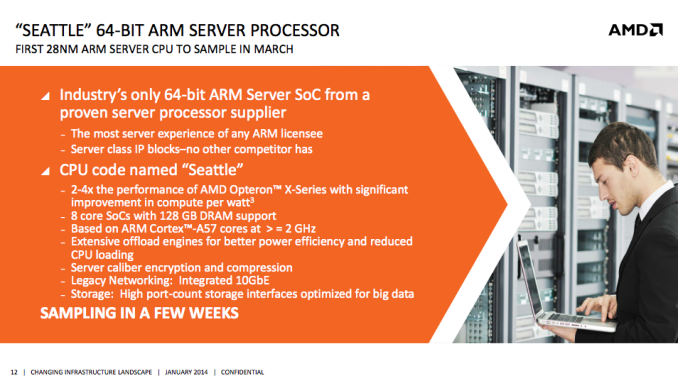
Around 15 months ago, AMD announced that it would be building 64-bit ARM based SoCs for servers in 2014. Less than a month into 2014, AMD made good on its promise and officially announced the Opteron A1100: a 64-bit ARM Cortex A57 based SoC.
The Opteron A1100 features either 4 or 8 AMD Cortex A57 cores. There's only a single die mask so we're talking about harvested die to make up the quad-core configuration. My guess is over time we'll see that go away entirely, but since we're at very early stages of talking about the A1100 there's likely some hedging of bets going on. Each core will run at a frequency somewhere north of 2GHz. The SoC is built on a 28nm process at Global Foundries.
Each pair of cores shares a 1MB L2 cache, for a total of up to 4MB of L2 cache for the chip. All cores share a unified L3 cache of up to 8MB in size. AMD designed a new memory controller for the Opteron A1100 that's capable of supporting both DDR3 or DDR4. The memory interface is 128-bits wide and supports up to 4 SODIMMs, UDIMMs or RDIMMs. AMD will be shipping a reference platform capable of supporting up to 128GB of Registered DDR3 DIMMs off of a single SoC.
Also on-die is an 8-lane PCIe 3.0 controller (1 x8 or 2 x4 slot configurations supported) and an 8-port 6Gbps SATA controller. AMD assured me that the on-chip fabric is capable of sustaining full bandwidth to all 8 SATA ports. The SoC features support for 2 x 10GbE ports and ARM's TrustZone technology.
AMD will be making a reference board available to interested parties starting in March, with server and OEM announcements to come in Q4 of this year.
It's still too early to talk about performance or TDPs, but AMD did indicate better overall performance than its Opteron X2150 (4-core 1.9GHz Jaguar) at a comparable TDP:
| AMD Opteron A1100 vs. X2150 | |||||||||
| CPU Core Configuration | CPU Frequency | SPECint_rate Estimate | SPECint per Core | Estimated TDP | |||||
| AMD Opteron A1100 | 8 x ARM Cortex A57 | >= 2GHz | 80 | 10 | 25W | ||||
| AMD Opteron X2150 | 4 x AMD Jaguar | 1.9GHz | 28.1 | 7 | 22W | ||||
AMD alluded to substantial cost savings over competing Intel solutions with support for similar memory capacities. AMD tells me we should expect a total "solution" price somewhere around 1/10th that of a competing high-end Xeon box, but it isn't offering specifics beyond that just yet. Given the Opteron X2150 performance/TDP comparison, I'm guessing we're looking at a similar ~$100 price point for the SoC. There's also no word on whether or not the SoC will leverage any of AMD's graphics IP.
The Opteron A1100 is aimed squarely at those applications that either need a lot of low power compute or tons of memory/storage. AMD sees huge demand in the memcached space, cold storage servers and Apache web front ends. The offer is pretty simple: take cost savings on the CPU front and pour it into more DRAM.
Early attempts at ARM based server designs were problematic given the lack of a 64-bit ARM ISA. With ARMv8 and the Cortex A53/A57 CPUs, that's all changed. I don't suspect solutions like the Opteron A1100 to be a knockout success immediately, but this is definitely the beginning of something very new. Of all of the players in the ARM enterprise space, AMD looks like one of the most credible threats. It's also a great way for AMD to rebuild its enterprise marketshare with a targeted strike in new/growing segments.
AMD's Andrew Feldman included one of his trademark reality check slides in his Opteron A1100 presentation today:
Lower cost, high volume CPUs have always won. That's how Intel took the server market to begin with. The implication here is that ARM will do the same to Intel. Predicting 25% of the server market by 2019 may be feasible, but I'm not fond of making predictions for what the world will look like 5 years from now.
The real question is what architecture(s) AMD plans to use to get to a leadership position among ARM CPUs and a substantial share of the x86 CPU market. We get the first hint with the third bullet above: "smaller more efficient x86 CPUs will be dominant in the x86 segment".


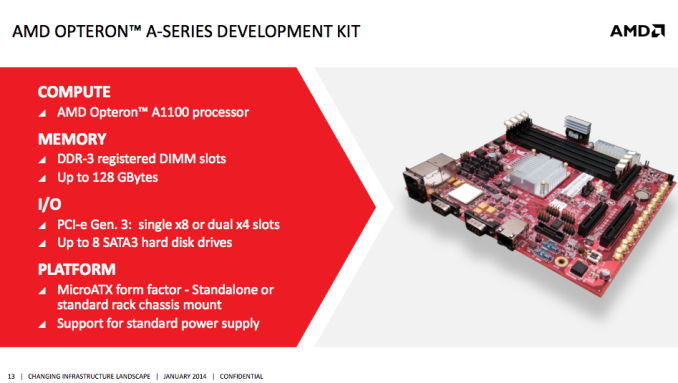
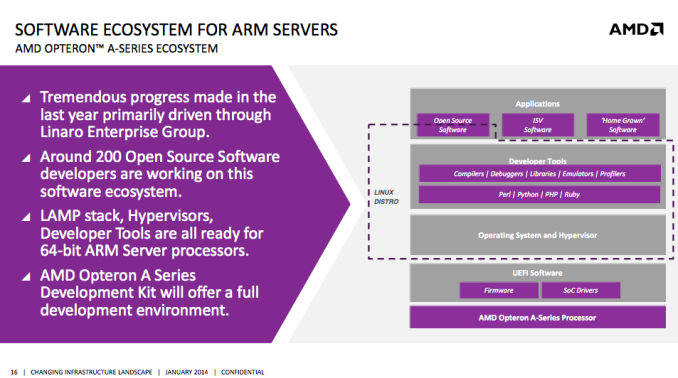
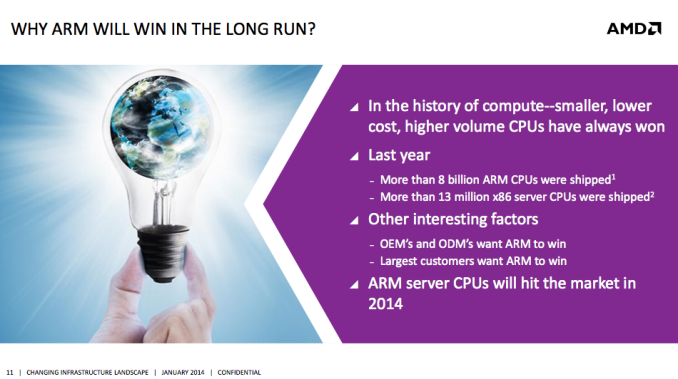
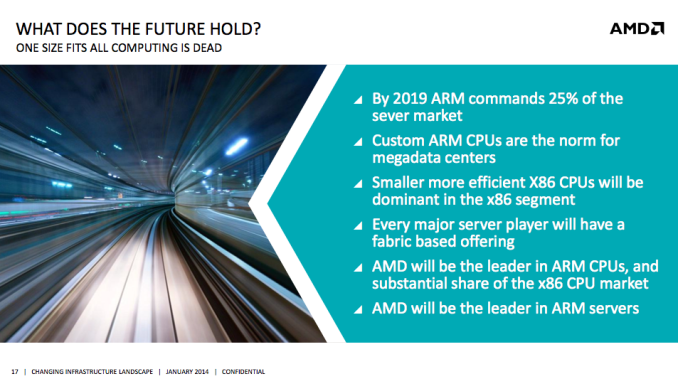








122 Comments
View All Comments
Klug4Pres - Wednesday, January 29, 2014 - link
I am confused by the article. Your "What does the Future hold" graphic shows a prediction that ARM (not AMD) will get 25% of the server market by 2019. But you then say this:"Predicting 25% of the server market by 2019 may be feasible, but I'm not fond of making predictions for what the world will look like 5 years from now.
The real question is what architecture(s) AMD plans to use to get to 25% of the server market and a substantial share of the x86 CPU market. We get the first hint with the third bullet above: "smaller more efficient x86 CPUs will be dominant in the x86 segment"."
Where do you get the bit about AMD planning to capture 25% of the server market?
My take on what AMD is actually saying:
1. Total ARM share of server market will be 25%. AMD will be the leading supplier of ARM server chips.
2. Within the x86 part of the market, smaller and more efficient CPUs will take share from today's bigger less efficient CPUs. AMD will have a substantial share of the x86 segment.
3. AMD is not making any prediction (e.g. it is not saying 25%) on its total share of the server market.
name99 - Wednesday, January 29, 2014 - link
To me it seems like a dog whistle to Wall Street.What it's saying, translated, is "You guys might think Intel has better tech than us, and maybe they do, but Intel's prices are on the wrong side of history and you need to ask yourself what happens to Intel as a BUSINESS as this pricing disparity becomes ever more obvious".
coder111 - Wednesday, January 29, 2014 - link
Interesting times. x86 compatibility doesn't matter that much if you are running Linux, and Linux rules on server-side. I think these CPUs have a chance. If they actually succeed or not will depend on many things- price, performance, features, power usage, software support from commercial vendors, hardware support from OEMs and availability. I wonder how fast is Java on ARM compared to Java on x86? JVM on x86 has been very heavily optimized. How about database servers? Language interpreters for PHP, Perl, Python, Ruby? They will all run on ARM, but how fast compared to x86?name99 - Wednesday, January 29, 2014 - link
That's the whole reason for the existence of Linaro. One package at a time, they are going through the standard LAMP stack and trying to fix whatever issues slow down the ARM compiled version of a program vs the x86 compiled version.They've been held back, to some extent, by ARM's taking its sweet time to get to 64-bit, but they have been working at it for a few years now, and you can go to their web site, see the various conference proceedings, and get a feel for the kind of thing they do.
sakthibruce - Wednesday, January 29, 2014 - link
Love to c a beagle bone running linux under 100usdextide - Wednesday, January 29, 2014 - link
Beagle Bone Black.ddriver - Wednesday, January 29, 2014 - link
Too bad it has terrible graphics and only up to 720p output. ODROID-U3 Community Edition makes a bit more sense, a little more expensive at 59%, plus about 10$ you will have to add a microcontroller to it, in case you want GPIO.extide - Wednesday, January 29, 2014 - link
Depends on what your goals are. Not every app needs graphics.KenLuskin - Wednesday, January 29, 2014 - link
Graphics is a whole other area that AMD is now DOMINATING because it is based upon success in gaming.Graphics is becoming more important, and this is the reason that AMD will be successful with X86 server chips that are optimized for Video/Graphics/GPGPU.
hetzbh - Wednesday, January 29, 2014 - link
One thing that I don't see anywhere: What about virtualization? I see the graph includes Hypervisors in the OS level, but no hardware virtualization anywhere..